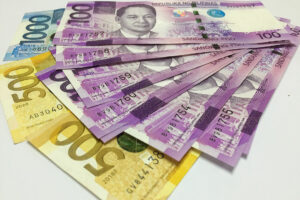




Monthly Economic Update: One for the road
 DOWNLOAD
DOWNLOAD

Inflation Update: Still low, still slow
 DOWNLOAD
DOWNLOAD

Philippines Trade Update: Exports momentum continues
 DOWNLOAD
DOWNLOAD


January credit growth slowest in 9 months

BANK LENDING expanded in January at its slowest pace in nine months, reflecting the impact of rising interest rates.
Preliminary data from the Bangko Sentral ng Pilipinas (BSP) released late on Tuesday showed outstanding loans by big banks, net of reverse repurchase (RRP) placements with the BSP, rose by 10.4% to PHP 10.71 trillion in January from PHP 9.70 trillion a year earlier.
January credit growth, which eased from the revised 13.7% in December, was the slowest pace in nine months or since the 10.1% expansion in April 2022.
Month on month, outstanding universal and commercial bank loans, net of RRPs, were broadly unchanged, the BSP said.
“Brisk credit growth and adequate liquidity will continue to sustain the momentum of economic growth,” BSP Governor Felipe M. Medalla said in a statement.
Lending to residents, net of RRPs, jumped by 10.2% in January, easing from the 13.5% rise in December.
Borrowings for production activities rose by 9.2% year on year, slower than the revised 12.4% growth in December.
This was mainly due to double-digit growth in loans for key sectors such as electricity, gas, steam and air-conditioning supply (12.7%), wholesale and retail trade (10.4 %), manufacturing (10.3%), and information and communication (21.4%).
Lending for real estate activities rose by 3.5% in January, while those for accommodation and food services (-4.8%), and education (-5.8%) declined.
Consumer loans climbed by 20.3% in January, easing from the revised 25.1% growth in the prior month.
Credit card loans (30.7%) and salary-based general purpose consumption loans (67.1%) continued to show double-digit growth, while borrowings for motor vehicles contracted by 4.4%.
Outstanding loans to nonresidents grew by 16.8% in January from 19.9% (revised) a month ago.
“Consumer loans and loans for production activities both grew at slower paces, likely due to high interest rates and inflation,” China Banking Corp. Chief Economist Domini S. Velasquez said in a Viber message.
“The continued double-digit growth still pointed to robust demand and was likely supported by positive sentiments on the economy’s growth prospects,” she added.
The benchmark interest rate stood at 5.5% in January, after the BSP raised borrowing costs by a total of 350 basis points (bps) since May 2022. Rising food and utility costs continue to rise, driving inflation to a 14-year high of 8.7% in January.
In February, the Monetary Board increased rates by another 50 bps that brought the policy rate to 6% or the highest in nearly 16 years.
Rizal Commercial Banking Corp. Chief Economist Michael L. Ricafort said credit demand may have been dampened by higher interest rates.
“The slower pace of universal/commercial banking loans, though still decent and among the fastest in nearly three years, may have to do with higher US/global/local interest rates that increased borrowing costs/funding costs that somewhat slowed down demand for loans,” he said.
Since March 2022, the US Federal Reserve hiked rates by 450 bps to 4.5-4.75%.
“Going forward, these risk factors are still somewhat (be) overshadowed by measures to further reopen the economy, (that could) fundamentally increase demand for loans,” Mr. Ricafort added.
The economy grew by 7.6% in 2022, surpassing the government’s target of 6.5-7.5% for last year.
However, Ms. Velasquez said loan growth may further soften this year “as the economy is expected to feel the full impact of the BSP’s rate hikes this year.”
“We think if inflation will behave and trend down, we think one more small rate hike should be sufficient to balance monetary tightening and support economic growth,” she added.
The government is targeting 6-7% economic growth this year.
M3 growth
Meanwhile, domestic liquidity grew by 5.5% in January, slower than the revised 6.7% in December, BSP data showed.
M3 — which is the broadest measure of money supply in an economy — was broadly unchanged on a month-on-month seasonally adjusted basis.
Meanwhile, domestic claims rose by 11.3% in January, easing from the revised 12.7% in December amid sustained bank lending to the private sector.
Net claims on the central government increased by 16.5% in January, easing from 20.8% in December, while claims on the private sector jumped by 10.5%, slightly slower than December’s 10.8%.
Growth in net foreign assets (NFA) declined by 1% in January, an improvement from the 3.5% contraction in December.
“The NFA of banks contracted mainly on account of higher bills payable. Similarly, the BSP’s NFA position fell marginally by 0.2% in January,” the BSP said.
“Looking ahead, the BSP will continue to ensure that overall domestic liquidity conditions remain consistent with the prevailing stance of monetary policy, in line with the BSP’s price and financial stability objectives,” it added. — Keisha B. Ta-asan
This article originally appeared on bworldonline.com





 By BusinessWorld
By BusinessWorld